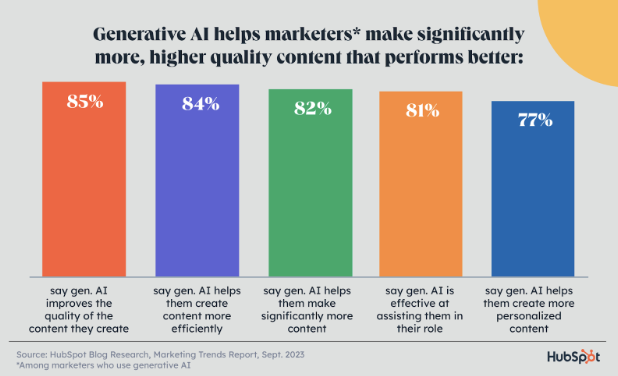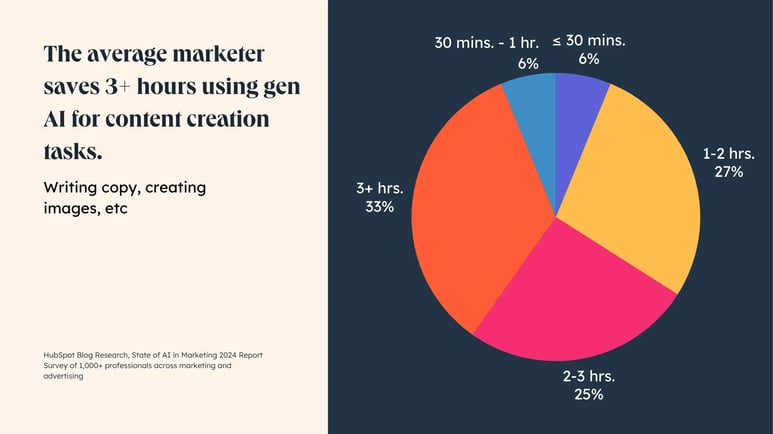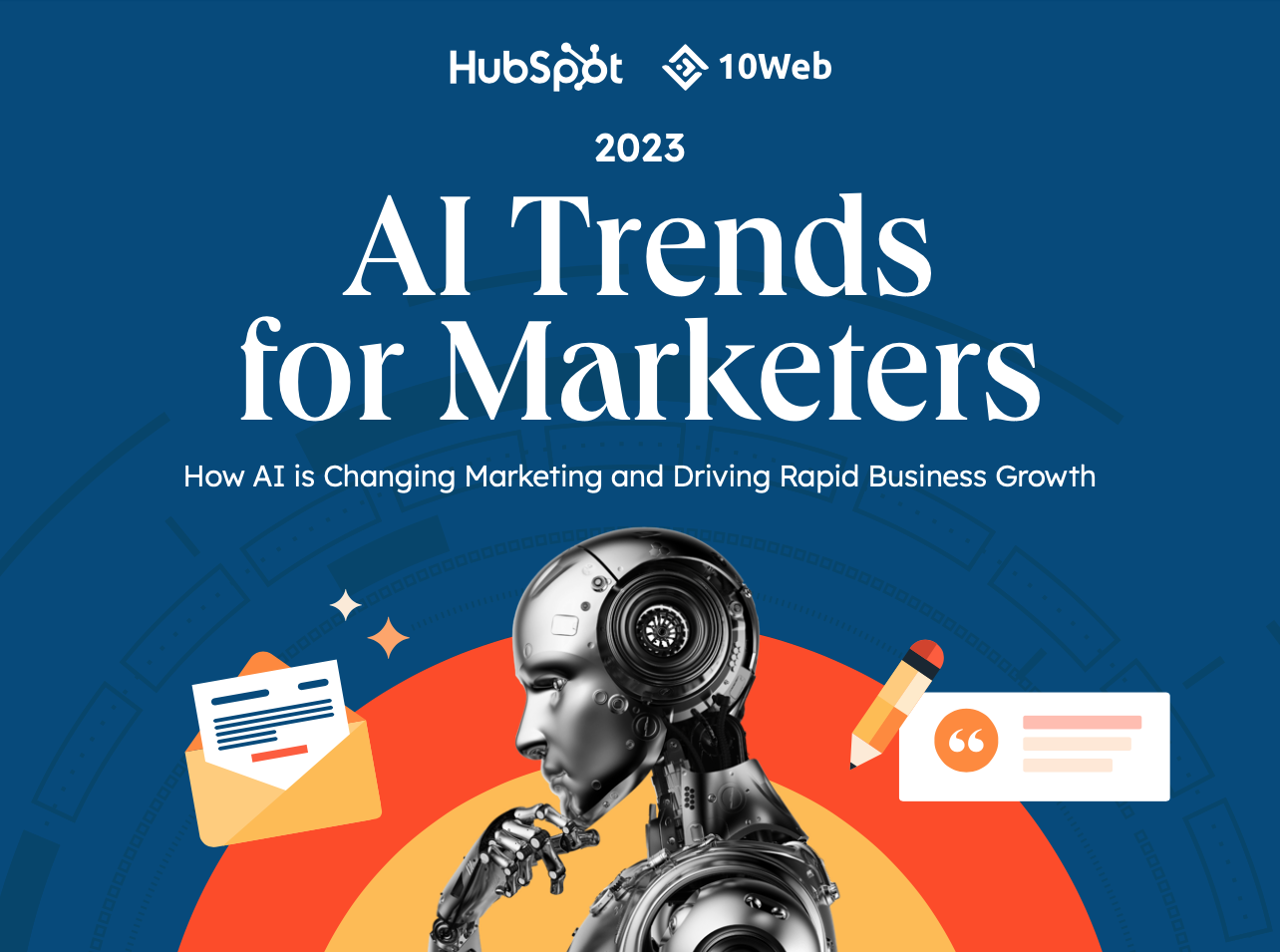In a Mint Mobile commercial, Ryan Reynolds reads from a script written entirely by ChatGPT. His prompt was simple (include a joke, curse word, mention the holiday promo in his voice), but he calls the results “compelling” but also “mildly terrifying.”

I think the ad is a great example of one of the many ways marketers can use generative AI: to streamline the creative process.
Reynolds’ use is just one application of many, though, and I’ll go over more generative AI use cases in marketing in this piece, using data from our 2024 State of AI Survey. Let’s see how marketers already use it and how you can leverage it yourself.
Table of Contents
- Benefits of Gen AI for Marketing
- Generative AI Use Cases in Marketing
- The Pitfalls to Avoid When Implementing Generative AI Into Your Processes
Benefits of Gen AI for Marketing
Generative AI offers very real benefits for marketers, and here’s what I learned from our data:
- Generative AI improves the quality of content they create
Most marketers say that the content they make with generative AI performs somewhat better than content created without it
- Generative AI helps them create content more efficiently
Global marketers say that the most impactful result of using AI is that it makes them more productive.
- Generative AI helps them make significantly more content
75% of marketers agree that AI can help them spend less time on manual tasks (like data entry, scheduling meetings, etc.), which gives them time to focus on content creation duties.

Marketers also save a significant amount of time using gen AI: 3+ hours when using gen AI for content creation tasks like writing copy, creating images, getting ideas, etc. With this time back, us marketers can let go of manual tasks and focus on responsibilities that need our human touch.

85% of marketers believe AI is effective at helping marketers create more personalized content, which speaks to consumers' desire for personalization and experiences directly relevant to them and their interests.
Gen AI can also help marketers feel more satisfied at work, as 73% agree that it helps them spend more time on the parts of their jobs they enjoy the most.
How can you reap these benefits yourself? Let’s dive in.

The State of Artificial Intelligence Report
New research into how marketers are using AI and key insights into the future of marketing.
- Marketing AI Tools
- Practical Tips
- Trends and Statistics
- And More!
Download Free
All fields are required.

Generative AI Use Cases in Marketing
Marketers who responded to our State of AI Survey told us that the top three tasks they use generative AI for in their role are content creation, research, and learning how to do new things.

The channels marketers most often use AI to create content for are email marketing and newsletters (48%), social media content for audio and video platforms (45%), and text-based social media content (44%).

Marketers report positive ROI from using gen AI to create content for audio/visual channels (48%) and search/SEO content (45%). Using gen AI for email marketing newsletters and text-based social media content most often yields somewhat positive ROI.
Let’s dive deeper into generative AI marketing use cases, featuring expert advice from Samyutha Reddy, Head of Enterprise Marketing at Jasper.
1. Generative AI for content creation.
As I mentioned, marketers told us they most often use gen AI to create content.
They use it to create images for marketing content (with AI art tools) and write copy for marketing content. This makes sense to me because, on the most basic level, all marketing content includes some sort of visual image, text, or both.

Gen AI can also help with more unique marketing tasks, such as generating the most effective and enticing email subject lines based on your historical open rates or translating your content for global audiences.
I like Reddy‘s example of using Gen AI to repurpose content. She says, “Being able to take super lengthy pieces of content, feed them into Jasper’s Content Synthesizer, and have a summary of different viewpoints and pieces of data can help creators form an opinion or perspective that much quicker.”
For example, if I’m converting a multi-page ebook into a blog post, I can speed up my process by pasting the copy into an AI tool and prompting it to list the biggest takeaways. The tool will identify key themes, topics, and ideas, which I can use as a rough draft for my blog. I add my voice and expert perspective, and I’d have a new piece of content that took a fraction of the time to create.
All in all, 84% of marketers say gen AI helps them create marketing content more efficiently. Despite its benefits, most marketers aren’t handing over the reins. They aren’t asking ChatGPT to write an Instagram caption, copying the output into the caption box, and pushing it live. A majority say and recommend marketers use gen AI in their roles but avoid becoming overly reliant on it.
I like to view it as a trusty sidekick. It will give you ideas and help you create your outputs faster, but you make edits and have the final say.
2. Generative AI for content ideation.
As a writer, there‘s nothing worse than staring at a blank document. But these days, you don’t have to wait for inspiration to strike.
AI can help you get the ball rolling even faster than you usually might: marketers report saving 2-3 hours when using gen AI for brainstorming.
Reddy says, "AI really fits at the beginning of the writing process, particularly for content ideation. If I'm writing a blog, I often use Jasper Chat to test new ideas and try different angles, just like I would with a colleague in a conference room."

Reddy points out that AI tools are especially beneficial for remote marketers who don't have the physical space to spitball ideas with others.
“It‘s valuable during a time when people are working remotely and teams are distributed. We can get a lot accomplished in virtual meetings, but they’re not often used to just brainstorm or connect. In that way, AI can be really helpful,” she observes.
Tool Recommendation: I regularly use HubSpot’s AI Content Writer in my writing process. Sometimes I use it to create an entire outline; other times to come up with a section heading. Either way, it helps me kick off my process, whether I’m feeling stuck or not. The tool can also help you write social media copy, fill out your landing pages, and even write your marketing emails.

3. Generative AI for content research.
A lot of effort goes into writing articles before I even put pen to paper, and 99% of that effort is researching and sifting through information.
Language models have changed the game in this regard. Instead of sifting through search results, tools can help users access information and get answers in record time. For example, prompts like “What’s the difference between [topic] and [topic]?” or “What are the top trends in [industry] in 2024?” can surface specific responses that will help you through your process.
Marketers told us they get back 2-3 hours they’d typically spend conducting their own research using gen AI, so it’s already proven useful.
4. Generative AI for SEO optimization.
As content creators, we want our work to be seen by as many people as possible. One way to get there is by optimizing for SEO.
However, we’re not all experts in technical SEO. For Reddy, this is where AI can really shine.
She says, “I‘m not someone that grew up in the discipline of content marketing, and I never had a tool to help me with the technical aspect of SEO. That’s where Jasper comes into play. It can help content marketers optimize their articles by automating a lot of SEO tasks.”
In action, a generative AI tool could help you conduct keyword research, classify keywords by intent for more focused content, suggest content clusters for your blog, or help you write meta tags and descriptions to improve click-through rates.
But AI doesn't end at optimization — it can also work as an editor during the final stages of writing. Tools like Grammarly can detect wordiness, offer alternative phrases, and improve readability. The result? SEO-optimized content that people enjoy reading.
Tool Recommendation: As consumers also get more and more usage out of AI search engines, you want to ensure your website is set up to appear in those results. Enter HubSpot’s AI Search Grader, a free app that quickly analyzes your brand based on what your prospects & customers are seeing across AI search engines, then gives you actionable recommendations on how to improve.
5. Generative AI for scaling marketing campaigns.
In an ideal world, there would be a single channel to meet, engage, and convert customers. In reality, marketers need a multi-channel strategy to reach their audience.
Of course, scaling marketing campaigns is no easy feat. As Reddy puts it, “We often burn all our energy on creating one beautiful, optimized piece of content. But then our distribution falls.”
However, marketers can use AI to build entire marketing campaigns from one piece of content, which they can adapt to different formats and lengths.
For example, if I create a YouTube video I want to scale into an entire campaign, I can use AI to convert the video script to different formats, like a LinkedIn Post, Facebook ad, or newsletter copy. I’ll have a multi-channel strategy rather than a single platform or format. It also helps me strategically ramp up my marketing.
Reddy underlines this point, telling me, “It enables me to truly be a project manager and a strategist, versus someone who is waiting on other people to deliver their end of the bargain.”

The State of Artificial Intelligence Report
New research into how marketers are using AI and key insights into the future of marketing.
- Marketing AI Tools
- Practical Tips
- Trends and Statistics
- And More!
Download Free
All fields are required.

The Pitfalls to Avoid When Implementing Generative AI Into Your Processes
1. Removing creators from the creation process.
“When incorporating generative AI, the worst thing you can do is remove someone with a strong creative or editorial eye,” cautions Samyutha.
At first glance, AI-written content may look perfect. Yet, many human elements — like humor, empathy, perspective, and cultural context — could be missing. On top of that, generative AI operates with limited data, so the information it collects could be irrelevant, outdated, and even biased.
Most marketers told us they’re only somewhat confident they’d know if the information gen AI provides is accurate, but they have similar thoughts to Reddy. A majority use gen AI to give them an outline/draft to build off of, and a majority also make significant edits to the text that gen AI produces.

Ultimately, I recommend using AI as your first draft — not the last. It can lay the groundwork, but you still need to elevate the content with your unique personality or perspective.
2. Recreating the wheel.
Every marketing team has a different strategy for creating content. As a result, your approach to AI — and how you choose to implement it — is unique to your team.
While AI is exciting and new, Reddy recommends the “less is more” approach when adding it to your workflow.
She tells me, “When it comes to integrating AI, a lot of teams feel pressure to recreate the wheel. However, you don't have to build all your processes around generative AI. Instead, incorporate AI into your existing processes that already work well.”

For example, a marketing team may have an effective content distribution process, but it could be improved by automating some tasks with AI — like scheduling social media posts and reformatting content for different channels.
With this approach, your marketing strategy isn‘t dependent on AI; it’s improved by it.
3. Raising content demands too quickly.
As AI continues to speed up the creation process, it's important to have guardrails in place to maintain quality.
Reddy says, “We have multiple processes built to check our work, and that doesn‘t go away because Jasper’s in the picture. If anything, that chain link of feedback is strengthened so we can catch things like inaccuracies or mistakes.”
She continues, “It‘s not about creating content as quickly as you can. It’s about effectively incorporating another piece of technology into your existing workflow.”
Over to You
Us marketers are always looking for ways to stay ahead of the curve and embrace new technology that helps us be more effective. Generative AI is a huge opportunity, but as Reddy puts it, it’s important to always be realistic about this technology.
Ultimately, it's about knowing when to push this technology into your workflow — and when to pull back. With this approach, marketers can effectively incorporate AI into their strategies for maximum impact.



![The Top Types of AI-Generated Content in Marketing [New Data, Examples & Tips]](https://www.hubspot.com/hubfs/top%20types%20of%20ai%20generated%20content%20in%20marketing.png)



![New Marketing Jobs That Could Focus on AI [Data + Examples]](https://www.hubspot.com/hubfs/Untitled%20design%20%2832%29.jpg)


![Which AI Tool Writes the Best Marketing Copy? [I Tested Several Different Tools]](https://www.hubspot.com/hubfs/Untitled%20design%20%2842%29-1.jpg)
